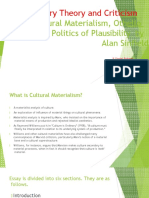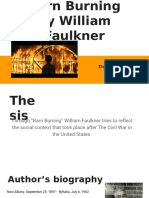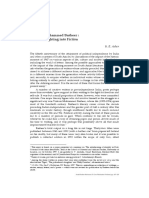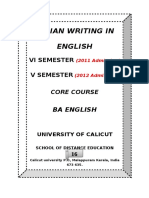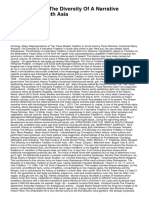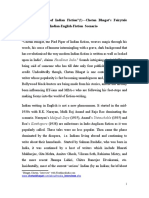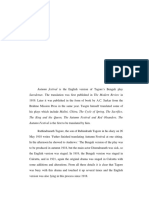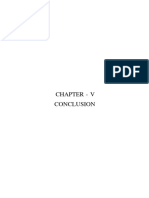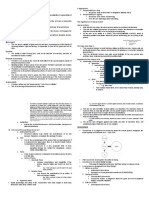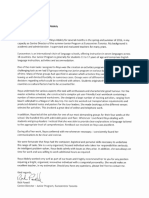Module 2
Unit 2.1
No Alphabet in Sight- Poikayil Appachan
Translated by Catherine Thankamma
Poikayil Appachan, founder of Prathyaksha Raksha Daiva Sabha, wrote his Songs as a
critique against caste and religious norms. Being a Dalit, Appachan converted into
Christianity expecting a dignified life. But he soon realized how Christianity in Kerala with
its many Churches could only reproduce the caste divisions of Hinduism. Disheartened by the
condition of permanent marginality, he wrote Songs as both a personal lamentation and social
critique. He questioned the discrimination towards the lower castes and their segregation in
the newly found religion. He was twice nominated to the Sree Moolam Praja Sabha and “No
Alphabet” was reportedly recited in the Assembly in 1921. This song can be considered as
part of a Literature of Protest or Literature of Revolt. It explores the absence of the poet’s
race and community in the written histories of the world, highlighting a sense of historical
erasure and injustice. Appachan questions the erasure of his race from history and also
challenges the notion of divine fairness in the face of human suffering.
Notes:-
My Race/ “Ente Vamsham” is an important construct in the ideology of the PRDS. In the
speech made on 1 March 1921, Appachan stated “They were the ancient race that made this
land fertile. At one point they became the slaves of the region”.
“Regret begins within me”: poet feels regret because in the numerous versions of history that
exist, the history of the downtrodden people is not present.
“Frailties of the caste”: vulnerabilities related to one’s caste in a casteist society
“How is it, that God…”: divine silence about caste-based discrimination forces the poet to
question the authority of God.
Questions: -
I. Part A
1. What is the central theme of the poem “No Alphabet in Sight”?
A. The beauty of nature
B. The importance of education
C. The historical neglect of the poet’s community
D. The power of love and friendship
2. According to the poem, what is the poet lamenting the absence of?
A. Physical letters from loved ones
� B. Records of his race’s history in official texts
C. Personal wealth and richness
D. Opportunities for social advancement
3. Why does the poet question God in the poem?
A. Because he created the world
B. Because he allows suffering
C. Because he allows the history of his community to be ignored
D. Because he created different communities.
4. The poem, “No Alphabet in Sight” can be considered to be part of ----
A. Romantic Literature
B. Protest Literature
C. Feminist Literature
D. Classical Literature
5. What does the poet mean by the line, “I see no alphabet about my race”?
A. His people were illiterate and couldn’t write their own history
B. There are no books or documents mentioning his race in historical accounts
C. His race doesn’t have a written language or alphabet
D. He is unable to find any information about his ancestors.
II. Part B
1. Explain the significance of the title “No Alphabet in Sight”.
2. How does the absence of a written history impact the poet’s sense of identity and
belonging?
3. Discuss the plight of a race without history in Appachan’s song.
4. What is the world’s attitude to the people of his race?
5. What does the poet want to write about ?
� Unit 2.2
Anukampa Dasakam (Scriptures of Mercy) by Sree Narayana
Guru
Translated by Nataraja Guru
“Anukampa Dasakam” is a ten-verse poem composed by Sree Narayana Guru in Malayalam
in 1920, extolling the virtues of compassion, empathy, and kindliness. The poem centres
around the idea that true compassion stems from a divine source and is essential for spiritual
progress. The poem refers to great figures including Lord Krishna, Sri Buddha, Jesus, Adi
Shankara, Prophet Muhammed, Appar, and Sundarar as embodiments of compassion. The
verses highlight the connection between grace, love and mercy, and the detrimental effects of
a lack of compassion. A person without compassion is like a mirage in a desert or a flower
without fragrance or fruit, and an empty shell of bone and skin. The poem serves as a guide in
cultivating compassion and recognizing its presence in oneself and others. The concluding
verse or envoi stresses on the fact that the meaning and teachings of all religions, all gurus,
all sages and different branches of wisdom are same and their aim is to improve humans and
to be human was the quintessential saga of the Kerala renaissance.
Notes:-
Brook: tolerate, allow
Vouchsafe: to grant or furnish often in a gracious or condescending manner.
Mercy-maker: embodiment of mercy, God
Effacer: to erase, to remove
Bereft: deprived of or lacking something
“That Dispenser of Mercy … the chariot drives”: Lord Krishna drove the chariot of Arjuna in
the Kurukshetra war and convinced him of his duty.
“Compassion’s … all creation”: Lord Buddha as an ocean of compassion. His compassion is
an all-encompassing one that extends to all sentient beings, not just humans.
“Who in terms … the guru”: Non-dualism or Advaita of Adi Shankaracharya asserts that the
individual self (Atman) and the ultimate reality (Brahman) are ultimately one and the same.
“In human semblance … divinity”: Nara- Narayana are divine sages in Hinduism, often
depicted as human forms of the divine, specifically incarnations of Lord Vishnu.
“Law of right … human form”: Lord Rama, revered as the seventh avatar of Vishnu, is often
called “the lord of right” or “embodiment of righteousness” because he embodies the ideal
qualities of a human being and upholds dharma throughout his life.
“Pure-begotten Son of the Lord”: Jesus Christ as the son of God
In Anukampa Dasakam, Guru has mentioned “Nalvar” as the Dispensers of Mercy. Nalvar
refers to the four great saints of Shaivism in the Tamil tradition. These saints are – Appar,
�Sundarar, Sambandar and Manikkavacakar. They are revered for their devotion to Lord Shiva
and their contributions to Shaiva Siddhanta philosophy and Tamil devotional literature.
“Is He that … wonders worked”: Thirugnana Sambandar, who cured the fever of a king using
holy ashes.
“Other psychic … with song”: Appar, whose severe stomach illness was cured by a mantra.
“Sage of crowning … Hara’s name”: Manikkavacakar, composed numerous songs dedicated
to Lord Shiva, which are collectively called “Thiruvasagam”. According to a popular legend,
it was Lord Shiva who wrote down the saint’s hymns in the “Thiruvasagam”.
“Who here departed … stilled”: Sundarar is said to have died by ascending to the celestial
abode of Kailasa on a white elephant.
“…Kama- Dhenu cow...”: It may refer to the Kings who showed compassion in a sublime
manner. King Shibi, the generous one is said to have saved the life of a dove by offering his
own flesh.
“Deva- Taru…”: Guru hints at the compassion shown by Karna of the Mahabharata and
Rantideva.
Questions:-
I Part A
1. Who among the following was the author of “Anukampa Dasakam”?
A. Ayyankali
B. Kumaran asan
C. Chattampi swamikal
D. Sri Narayana Guru.
2. Guru’s work, “Anukampa Dasakam” is primarily known for its focus on:
A. political activism
B. love and compassion
C. Economic Development
D. Scientific Theories
3. Which poem of Guru consists the idea, one must not inflict even the slightest harm on an
ant?
A. Atmopadesa Satakam
B. Daiva Dasakam
c. Anukampa Dasakam
D. Darsana Mala
�4. Who among the following is not part of the Nalwar (The four Tamil Saivite Saints)?
A. Appar
B. Sundarar
C. Manikkavacakar
D. Andal
5. In the context of “Anukampa Dasakam”, what does the term ‘Anukampa’ primarily refer
to?
A. Anger and resentment
B. Patience and tolerance
C. Compassion and sympathy
D. Physical prowess and strength
II Part B
1. Explain the meaning of the line “He who loves is he who really lives”.
2. How are “Grace, love, and Mercy” related in the poem?
3. Who are the embodiments of compassion in the poem?
4. What is the core message of the poem, “Anukampa Dasakam” and how does it relate
to the concept of non-violence (Ahimsa)?
5. Explain the core message contained in the concluding verse or envoi?
� Unit 2.3
Chandala Bhikshuki, Canto II by Kumaran Asan
Translated by G. Kumara Pillai
Kumaran Asan was born in 1873 in Kayikkara, a coastal village. At the age of seventeen, he
came under the influence of Sree Narayana Guru, who made a profound impact on his future
career both as a poet and a social reformer. Following the Guru’s words, he spent about five
years outside Kerala, at Madras, Bangalore and Calcutta. Calcutta, at that time, was the nerve
center of Indian renaissance. The new wave of cultural reawakening that swept through
Bengal during the last decades of the Nineteenth century, guided by Swami Vivekananda and
Rabindranath Tagore created an indelible impression on the young mind of Kumaran Asan.
In 1900, he returned to Aruvippuram and started actively participating in the social reform
movements initiated by Guru. Asan was a humanist to the core. He believed that man, in spite
of his several preoccupations with temporal and transient problems of day-to-day existence,
had an element of the divine in him. He was the General Secretary of the SNDP Yogam for
about 16 years and a member of Travancore Legislature. In both these capacities he devoted
his time and energies to bring about radical changes in the social relations between caste and
communities. Kumaran Asan died in a boat accident at Pallana river near Alappuzha in 1924,
at the age of 51.
Kumaran Asan’s legacy in Malayalam literature is unparalleled. He along with Vallathol
Narayana Menon and Ulloor S. Parameswara Iyer form the great trio of Malayalam poetry.
Asan was a revolutionary poet who brought a modern sensibility to traditional poetry,
blending classical forms with contemporary themes of social justice and humanism. His
major works are “Veena Poovu” (The fallen flower), “Nalini”, “Leela”, “Duravastha”,
“Chinthavishtayaaya Sita” and “Karuna”. Chandala Bhishuki is a khandakavya (a shorter
narrative poem). An incident mentioned in “The Essence of Buddhism” by Prof. Lakshmi
Narasu was the inspiration behind the poem. The poem centres around a Buddhist monk,
Ananda, who, while travelling, asks a woman, from the “Chandal” (an untouchable caste) for
water. She was shocked to hear that request and answered “How dost thou ask water of me,
an out-caste who may not touch thee without contamination?”. Ananda replied, “My sister, I
ask not of thy caste, I ask thee of water to drink”. Despite societal norms forbidding such
interaction, Matangi offers him water. Later, Lord Buddha admitted her into the order of
Bhikshunis. This poem explores the themes of caste-based discrimination and the
transformative power of love and compassion.
Notes:-
Haste: doing things quickly, hurry
Alas: an old-fashioned expression of sadness or disappointment
Chamar chief: chamar denotes a particular caste in India, which earlier had the status of
untouchables
Parched: extremely thirsty (here)
�Stamen: the pollen-bearing part of the flower
Affliction: to cause suffering, grief or distress
Bhikshu: a wandering mendicant
Marajit: synonym of Buddha
Nymph: minor goddess in Greek and Roman mythology
Herald: a forerunner, a sign of the approach of something
Cupid: a winged figure of a young boy carrying a bow and arrow, representing the Roman
god of love.
Questions:-
I Part A
1. Which social evil does the poem Chandala Bhikshuki primarily address?
A. Poverty
B. Illiteracy
C. Caste discrimination
D. Gender inequality
2. What is the name of the central female character in the poem?
A. Sita
B. Draupadi
C. Matangi
D. Savithri
3. What is the profession of the Buddhist monk who encounters the Chandala woman?
A. A Farmer
B. A King
C. A Wandering Mendicant
D. A scholar
4. What is the literary form of “Chandala Bhikshuki”?
A. A Short Story
B. A Novel
C. A Drama
D. A Khandakavya
5. What does the Buddhist monk ask the Chandala woman for?
A. Money
B. Food
C. Water
� D. Shelter
II Part B
1. How does Asan question caste discrimination in the poem?
2. Explain the dilemma in the poem.
3. Discuss the presence of love and compassion in the poem?
4. What does the title “Chandala Bhikshuki” mean?
5. Explain the significance of the line, “I didn’t ask your caste, my sister” in the poem
“Chandala Bhikshuki”.
� 2.4
From the Kitchen to the Stage- V. T. Bhattathirippad
V. T. Bhattathiripad, the pioneer of Yoga Kshema Sabha, was a distinguished social critic,
playwright, and one of the foremost advocates of social reform in Kerala, particularly within
the Namboothiri community. His play “Adukkalayil Ninnum Arangatheku” (From the
Kitchen to the Stage), is a landmark work in Malayalam literature that advocated for
women’s empowerment and social reform within the Namboothiri community. The play, first
staged in 1929, focused on the subjugation of Namboothiri women, the need for education,
and the importance of gender equality. The Namboothiri community, once the dominant
Brahmin caste of Kerala, upheld a rigid patriarchal structure that severely restricted the rights
and freedom of its women. Namboothiri women were called Antharjanams, meaning those
who live inside. They were confined to the interiors of their Illams and had minimum
interaction with the outside world. Their education was largely limited to religious scriptures
and domestic skills. They had no inheritance rights within their own families. Child marriage
was a common social practice, with girls being married off as early as five or seven years of
age, while boys married at ten years or older. In a Namboothiri family, only the eldest could
marry within the community. Others followed Sambandha. Thus, polygamy was legitimized
for Namboothiri men, while chastity was a fundamental expectation for Namboothiri women.
Due to significant age gaps between spouses, young brides frequently became widows at an
early age. Widow remarriages were strictly prohibited in the community. They were
subjected to extreme austerity, including practices such as shaving the head, wearing plain
white clothing, taking cold water baths, and refraining from betel leaf consumption, jewellery
and, festive gatherings. Smartha Vicharam was conducted in a forceful manner for the trial of
adulterous women in the community.
The Yoga Kshema Sabha was started by a group of radical Namboothiris in 1908 to eliminate
superstitious and obsolete customs within the community. Some of the slogans raised by the
radicals were – ban polygamy, put an end to the practice of old men marrying young girls,
permit the remarriage of widows, and a change in the unnatural laws of inheritance. “From
the kitchen to stage” was performed during the annual conferences of the Yoga Kshema
Sabha. The play’s central theme revolves around Devaki alias Thethi, a young Namboothiri
girl, whose marriage is arranged with an old man who already had four velis. Thethi’s life is
confined to the ‘adukala’, a symbol of her limited existence and societal restrictions. Through
the play, the audience witnesses Thethi’s internal conflict and her yearning for a different life,
a life beyond the kitchen and the confines of her community. The arrival of Madhavan, a
young man seeking to learn Koothu in Thethi’s village, becomes a catalyst for change.
Madhavan’s interaction with Thethi and her brother Kunju, sparks a desire for reform within
them. The play’s impact was profound, inspiring many Namboothiri women to break free
from domestic confinement and actively participate in the nationalist movement. Scenes
twelve and thirteen from the play are given here and these scenes are related to an injunction
order issued by the Second-Class Magistrate to stop the wedding between Virupakshan
Namboothiripad and Thethi.
Notes:-
Pattu Rasi: the moment when the sun sets, not a good time for auspicious things
�Otikkan: a priest in the Namboothiri community who is in charge of special rituals related to
birth, wedding, death etc
Kanikradal: a Vedic utterance or mantra sung before auspicious ceremonials for universal
well- being and prosperity
Tattu: In Namboothiri tradition, Tattu refers to a specific way of draping a cloth often a
double-layered one, where an edge of it is twisted in the shape of a conch and tucked in at the
front side and back.
Questions:-
I Part A
1. Who is the author of the play “From the Kitchen to the Stage”?
A. Virupakshan Namboothiripad
B. V T Bhattathiripad
C. Madhavan
D. Thethi
2. When was the play “From the Kitchen to the Stage” first staged?
A. 1930
B. 1929
C. 2012
D. 2018
3. How did “From the Kitchen to the Stage” contribute to the Kerala Renaissance
movement?
A. By promoting traditional Namboothiri practices
B. By criticizing social injustices and encouraging women’s empowerment
C. By focusing on religious themes
D. By showcasing historical themes
4. Who is the main female protagonist in the play, “From the Kitchen to the Stage”?
A. Savitri
B. Parvathi
C. Devaki (Thethi)
D. Lakshmi
5. What social issue did “From the Kitchen to the Stage” primarily address?
A. Untouchability
B. Caste Discrimination
C. Women’s subjugation and the need for their empowerment within the
Namboothiri community
D. Poverty
II Part B
1. What is the significance of the title, “From the Kitchen to the Stage”?
2. What is the central theme of the play?
3. Explain the significance of the injunction order in the play?
4. How did the play challenge the existing social structure?
5. Discuss the impact of the play on the social reform movements in Kerala, especially
within the Namboothiri community.
� 2.5
Onapattu by Sahodaran Ayyappan
Sahodaran Ayyappan was a thinker, reformer, journalist and politician. He was a rationalist
who believed that social institutions of caste and religion were in fact hindrances to the birth
of a secular and rational civil society. He started a newspaper “Sahodaran” in the year 1917
to circulate the ideas which would free Kerala from the shackles of ignorance and casteism.
He used to quote from all religious texts in his paper and also raised the slogan “No caste, No
religion and No God”. Ayyappan’s rendition of the “Onapattu” appeared in the January-
February 1921 edition of “Sahodaran”. Ajay S. Sekher, author of Sahodaran Ayyappan:
Toward a Democratic Future, has included an English translation of “Onapattu” in the book
and considers it a political poem linked to the renaissance period in Kerala. This poem is
associated with the Onam festival, which commemorates King Mahabali’s annual visit to
Kerala who is known for his generosity and sense of justice. Ayyappan’s portrayal of the
Mahabali era emphasizes the absence of untouchability and other barbaric practices. Here we
have the first ten couplets of the poem, which create the image of a prosperous and just
society, where all people were equal, and there was no suffering or injustice. It stresses the
values of equality, compassion, and social harmony that are central to the festival’s spirit.
“Onapattu” is a reminder of an ideal past and, for some, a vision for a future society worth
striving for.
Questions:-
I Part A
1. Sahodaran Ayyappan’s “Onapattu” is considered a part of?
A. Bhakti movement in literature
B. The Renaissance movement in Kerala
C. Romantic poetry in Malayalam
D. Classical Tamil Literature
2. The poem, “Onapattu” reflects Sahodaran Ayyappan’s commitment to-
A. Religious Orthodoxy
B. Social equality and justice
C. Political conservatism
D. Traditional Art forms
3. “Onapattu” can be considered a critique of –
A. The caste system and its hierarchical structure
B. The agricultural practices of Kerala
C. The cultural traditions of Kerala
D. The political leadership of poet’s time
4. In which publication did Sahodaran Ayyappan’s rendition of the Onam song appear in
1921?
A. Mathrubhumi
B. The Hindu
C. Sahodaran
D. Yuktivadi
� 5. Which of the following describes the central theme of Sahodaran Ayyappan’s
“Onappattu”?
A. The valour of ancient warriors
B. The beauty of nature during Onam
C. The egalitarian spirit and the ideal reign of king Mahabali
D. The importance of religious rituals during festivals.
II Part B
1. Analyze the specific lines in the poem that convey the concept of egalitarianism and
unity.
2. Explore the idea of ‘Maveli nadu’ (Mahabali’s reign) as depicted in the poem. What
does it represent, and how does it contrast with the social realities of the time?
3. Discuss the significance of “Onapattu” in the context of the Onam festival and its role
in shaping Kerala’s cultural identity.
4. What does the poem suggest about the true meaning of Onam beyond its superficial
celebrations?
Discuss about the ideal utopian land shown in the poem
� 2.6
Saraswativijayam- Potheri Kunhambu
Potheri Kunhambu was a prominent social reformer, writer, and lawyer from North Malabar.
He actively worked for the betterment of the downtrodden believing that only education
could provide them with upward mobility. In the epigraph of his famous novel,
Saraswativijayam, he stated the central message as ‘education is the greatest wealth’. His
own life is a classic example of the benefits of education. After studying at Ezhuthupalli run
by his father, Kunhambu joined Kannur Government High School and received English
education there. As his family could not afford to send him for higher studies after
matriculation, he started to work as a postmaster in Malappuram. After that, he joined the
Magistrate’s court as a copy clerk. Later he passed the legal examination and became a
lawyer. Kunhambu was a successful and efficient advocate. He served as the legal advisor to
the Chirakkal royal family. His contributions to Malayalam literature include
Saraswativijayam, Thiyyar, Ramakrishna Sambadham, Mythri and Ramayana Sara Sadhana.
He also wrote critical essays on religious reform and the upliftment of the downtrodden in
Kerala Pathrika, Kerala Sanchari and Bhashaposhini.
Saraswativijayam published in 1892, depicts the social problems of the nineteenth century
North Malabar. Kunhambu used this novel as a didactic tool to critique society and advocate
for social reform. This novel shows the life of a man from an untouchable caste, who leaves
his village to escape the cruelty of his Namboothiri landlord. He obtains modern education
and returns as a judge. Eventually the judge presides over the trial of the very Namboothiri
landlord who once tried to kill him for not obeying caste hierarchy. It can be taken as the first
novel written in the perspective of the marginalized or the Dalits. Kunhambu was a colonial
intelligentsia who strongly believed that the only way to attain freedom from traditional caste
bondage was to accept modernity and colonial perspective. Saraswativijayam perfectly
encapsulates that vision and strongly argues for education as a tool for individuals from lower
castes to escape oppressive structures and gain respect in society.
Questions:-
I Part A
1. What is the central theme of the novel?
A. The superiority of the upper castes
B. The importance of traditional rituals
C. The transformative power of education
D. The glorification of colonial rule
2. The novel’s title, Saraswativijayam can be interpreted as:
A. The triumph of ignorance
B. The victory of knowledge and learning
C. The dominance of the upper castes
D. The plight of the lower castes
3. Which social issue is strongly criticized in the novel?
A. The lack of religious tolerance
B. The prevalence of child marriage
C. The system of caste- based oppression
� D. The exploitation of women
4. Which character in the novel represents the lower caste individual who faces
oppression?
A. Kuberan Namboothiri
B. Ramankutty Nambiar
C. Marathan (Jesudasan)
D. Subhadra
5. What is the fate of Marathan after being assaulted and left for dead by the Nambiar?
A. He dies from his injuries
B. He converts to Christianity, receives education, and becomes a judge
C. He seeks revenge on Nambiar
D. He remains in the same village and continues to suffer under the caste
system
II Part B
1. What specific role does education play in the narrative?
2. How does the novel depict the conflict between tradition and modernity?
3. What message does the novel convey about social reform?
4. What is the significance of the protagonist’s transformation in the novel?
5. How does the novel depict the colonial influence?
















